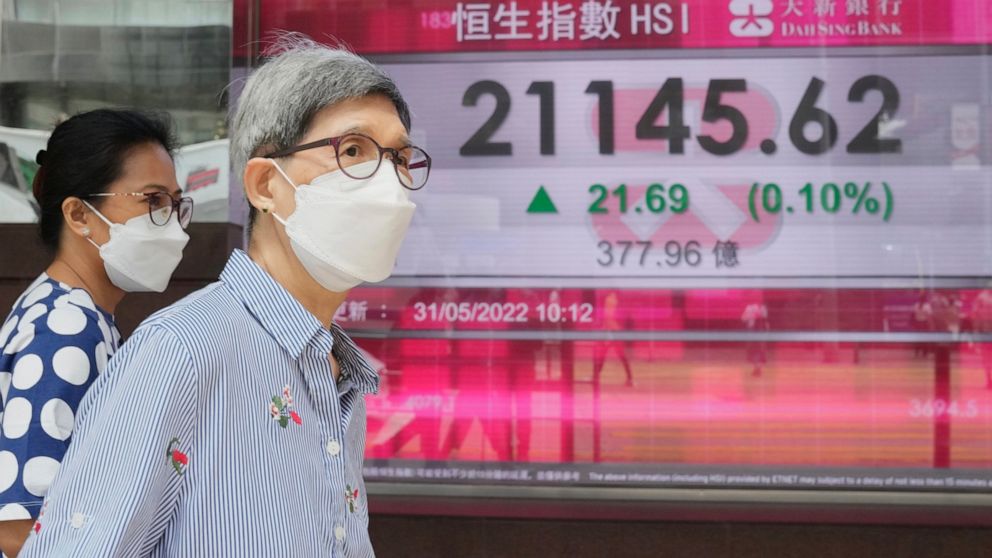Most stocks fall on Wall Street as crude oil prices climb
NEW YORK — U.S. stocks are falling Tuesday as Wall Street nears the end of a tumultuous month, bruised by worries about a possible recession, inflation and rising interest rates.
The S&P 500 was 0.9% lower in midday trading. The Dow Jones Industrial Average was down 270 points, or 0.8%, at 32,942, as of 11:34 a.m. Eastern time, and the Nasdaq composite was 0.8% lower.
Highlighting the worries about inflation, oil prices rose after the European Union agreed to block the majority of oil imports from Russia because of its invasion of Ukraine. Benchmark U.S. crude was up 1.8% at $117.19 per barrel. Brent crude, the international standard, was up 2 cents to $117.62 after earlier topping $120.
The jump of more than 50% for oil prices so far this year has been a big contributor to the very high inflation sweeping the world. Earlier Tuesday, a report showed inflation in the 19 countries that use the euro currency hit 8.1% in May, the highest level since records began in 1997.
In the U.S., President Joe Biden will meet with Federal Reserve Chairman Jerome Powell on Tuesday as soaring inflation continues to carve up Americans’ earnings.
The meeting Tuesday will be the first since Biden renominated Powell to lead the central bank and weeks after the Senate confirmed a second term. The White House said the pair would discuss the state of the U.S. and global economy and especially four-decade high inflation, described as Biden’s “top economic priority.”
The S&P 500 is on track for a 0.3% loss for May, which would bring it 14.1% below its record set early this year. But the slight move for the month belies the big swings that shook investors along the way.
For the first time since the dot-com bubble was deflating two decades ago, the S&P 500 tumbled to seven straight losing weeks through mid-May. Slowing data on the U.S. economy heightened worries that high inflation will force the Federal Reserve to raise interest rates so aggressively that it will cause a recession.
Some high-profile retailers also said inflation is eating into their profits, adding more urgency to the concerns. They all combined to bring Wall Street to the brink of what’s called a bear market, where the S&P 500 was on the verge of closing more than 20% below its record.
“Outside of a peace agreement in Ukraine, it’s difficult to construct a case for more than a bear market rally,” which would be just a temporary turn higher for stocks, Morgan Stanley strategists led by Michael Wilson wrote in a report. They said that the more stock prices rise, the more likely the Federal Reserve will be to hike interest rates.
But stocks have managed to avoid a full-blown bear market, at least so far, with the S&P 500 yet to close more than 20% below its record. The S&P 500 is coming off its best week in a year and a half, in part on hopes that inflation may have hit its peak and will begin moderating. Speculation has grown that the Fed may consider a pause in rate hikes at its September meeting.
Relaxing anti-COVID restrictions in China have also helped, easing some of the worries about the world’s second-largest economy and about more snarls to global supply chains.
China’s factory activity contracted again in May, but it’s almost back to growing. More factories, shops and other businesses are being allowed to reopen this week in Shanghai and in the Chinese capital, Beijing, after authorities declared outbreaks under control.
U.S. Treasury yields climbed following reports showing confidence among U.S. consumers was stronger than economists expected and home prices rose more than forecast.
The yield on the 10-year Treasury climbed to 2.86% from 2.75% late Friday.
Starting on Wednesday, the Fed will begin allowing some of the trillions of dollars’ worth of Treasurys and other bonds that it amassed through the pandemic to roll off its balance sheet. Such a move should put upward pressure on longer-term Treasury yields, and it’s one of the ways the Fed is trying to stamp out inflation by slowing the economy.
———
AP Business Writer Elaine Kurtenbach contributed.
![]()


